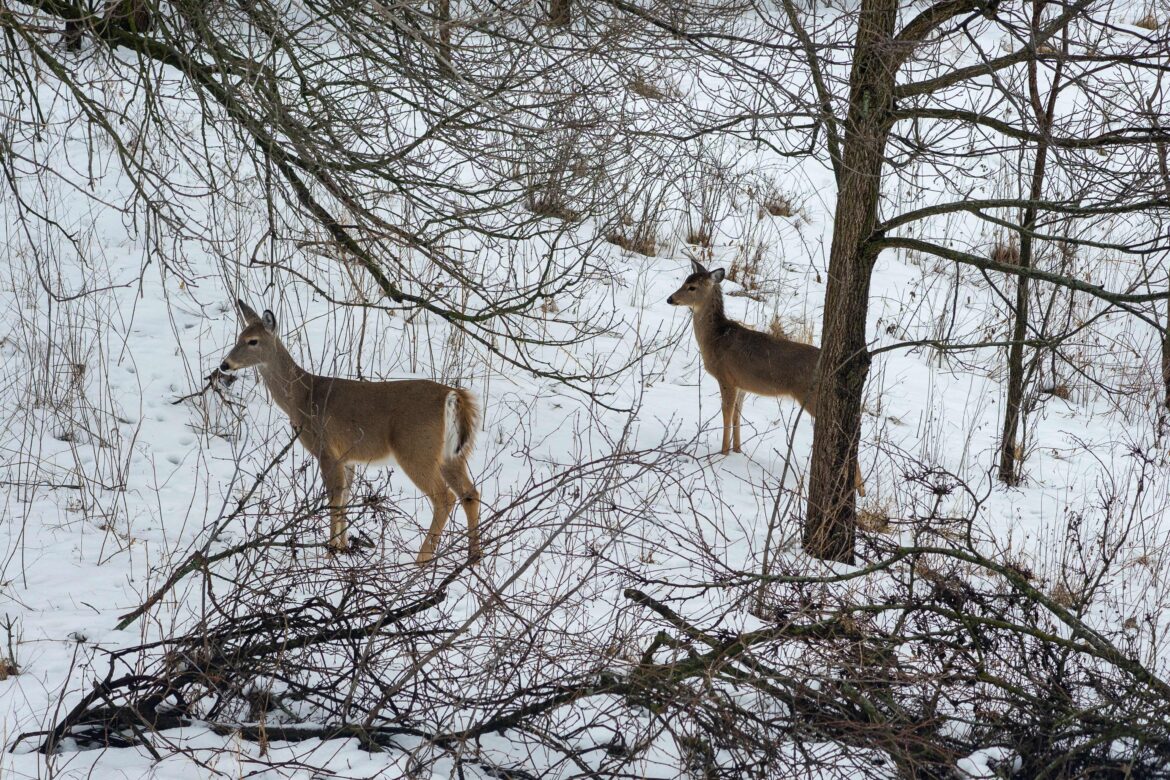
White-tailed deer. Image: Sam Corden
By Taylor Truszkowski
A recent study discovered a fast evolution of coronavirus in free-ranging white-tailed deer throughout Ohio. It implied possible animal-to-human transmission.
The study, published this year in August, found that the virus SARS-CoV-2 was introduced from humans to white-tailed deer more than 30 times in Ohio from November 2021 to March 2022. Deer-to-deer transmission then persisted for two to eight months, disseminating across Ohio.
The manuscript highlights findings from a full year of disease surveillance of white-tailed deer in Ohio, said study co-author Dillon McBride. “We collected nasal swabs, which is exactly what it sounds like. It’s the same swab you would get if you went to your physician for a covid test.”
McBride works for Ohio State University’s Animal Influenza Ecology & Epidemiology Research Program, which was responsible for sample collection and diagnostic testing.
Samples were collected from deer provided by hunters, deer-processing centers, butcher shops and research stations. Most were collected during hunting season.
State and federal agencies such as the Ohio Department of Natural Resources and the U.S. Department of Agriculture Animal and Plant Health Inspection Service assisted in sample collection at these research stations.
“We were just trying to collect as many samples as possible,” said J. Tyler Genders, a federal wildlife disease biologist who assisted in sample gathering. “We focused on more urban areas, because we were seeing a better correlation between what was happening in the human population compared to what the variant was in the wild white-tailed deer.”
One of the study’s goals was to collect samples from both rural and urban areas, according to Animal and Plant Health Inspection Service state director, Andrew Montoney. He said that the federal agency was focused on collecting samples from urban areas while the Ohio Department of Natural Resources focused on rural areas. The researchers sampled 83 out of 88 counties.
Chain of transmission
The study came after the discovery that free-ranging white-tailed deer are natural hosts for the virus, and that humans had given it to them.
“It’s called reverse zoonosis, which is when humans give a human disease to an animal host species,” said McBride. “A lot of animals have gotten infected. A lot of them are what we call dead-end hosts meaning that an animal gets infected and then basically nothing else happens. The animal may not even get that clinically ill.”
McBride said white-tailed deer are a natural host species with a lot of animal-to-animal transmission.
The opposite phenomenon is zoonosis, the transmission of a disease from an animal to a human. Both reverse zoonosis and zoonosis have important implications for public health.
“That poses a really big public health risk, not necessarily in an immediate sense but sort of in the long-term,” McBride said. “The great majority of new human diseases actually come from animals.”
The researcher said that there is limited evidence of deer-to-human transmissions because there are many barriers to gathering evidence.
According to McBride, in order to determine there has been a deer-to-human transmission, an infected person would have to first be determined covid-positive. Then, that virus has to get fully genome sequenced. If that sequence matches closely to a deer virus, it implies that the person possibly got it from a deer host, or from another human who got it from a deer host.
McBride said there is decent evidence that it occurred at least a few times. The possibility of deer giving the virus back to humans can breed future pandemic risks, since a virus can change as it passes through new hosts.

White-tailed deer (Odocoileus virginianus) passing through an apartment complex. Image: Jonus Cottrell
McBride said an example of this is the 2009 swine-origin influenza pandemic.
“Those gene segments eventually come from human seasonal flu into pigs. They evolve and diverge in that animal host and then they start to look really different,” he explained.
But Montoney and Genders said that virus mutation is common and expected.
“All viruses mutate,” Montoney said.
Genders said evidence of deer transmitting the virus back to humans is only presumed. However, he also said the biggest concern coming from this study is that the virus will mutate in deer and be passed back to humans.
The study did not answer those questions, Genders said. It shows merely the potent potential for these things to happen.
McBride said focusing on how the virus moves in white-tailed deer is the easiest first step to learning how it behaves in other species.
Genders said there has been similar research on rats in New York and on other species across the country. This implies that other species could also be natural hosts, but more evidence is needed to be sure.
Looking ahead
Studying white-tailed deer instead of other possible hosts can lead to more definitive global implications, such as virus movement across borders.
“Animals do not obey geopolitical borders,” McBride said. “The fact that animals can move freely points to challenges in control, both across state lines as well as international borders. We share a very large border with Canada that also has white-tailed deer.”
While this study implies coronavirus mutation and movement, Montoney warned against drawing hasty conclusions. He expects that more studies will be conducted on wildlife to resolve this study’s unanswered questions.
“Don’t make conclusions where there aren’t any,” Montoney said. “But with nature and the environment, never say never.”